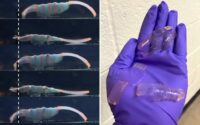Cure for baldness might be hiding in your hairy moles: study
You might be annoyed by a skin mole that sprouts hair, but that mole might hold the cure for baldness.
The secret, according to researchers at the University of California, Irvine, is a molecule known as osteopontin that’s found in hairy moles.
The human body is covered with hair follicles, most of which are so small they’re almost invisible.
But in moles, osteopontin causes these small, dormant “hair follicles to activate their stem cells for robust growth of long and thick hairs,” Maksim Plikus, UCI professor of developmental and cell biology, said in a news release.
If osteopontin can jolt stem cells into producing thick hair on moles, why can’t it also be used to produce thick, lustrous locks of hair on heads?
Plikus thinks it might.
“Nature essentially performed the most important experiment for us already: In millions of people, there are hairy moles that have increased osteopontin,” Plikus told Fierce Biotech.
“I see what we did as reverse-engineering nature’s experiment, and for this reason, I’m pretty excited that osteopontin really could be relevant to hair loss therapy,” Plikus said.

Osteopontin has been known for years as a critical part of wound healing, tissue remodeling and inhibition of bone mineralization, among other functions. But it hasn’t been recognized for its role in hair growth.
There are just a handful of treatments approved for hair loss — also called androgenetic alopecia — which affects up to 50% of men and women.
Rogaine (minoxidil), Propecia (finasteride) and Aldactone (spironolactone) can help some people with hair loss, but they’re not effective in everyone.

Reversing hair loss hasn’t been a pharmaceutical priority, either: “You don’t really die from hair loss, so it’s been underestimated,” Plikus said.
And stimulating hair growth seems like it should be straightforward: “People think, ‘How hard could it be?,’ but the reality is that it’s actually very hard,” he added.
After achieving encouraging results in mouse experiments and with human skin samples, Plikus and his team are preparing for clinical trials in humans this summer.
The treatments, which would likely involve osteopontin and some other hair-growing proteins, would be injected into the scalp using microneedles similar to those used in Botox treatments.

Plinkus — who is also co-founder of Amplifica, a startup company based in San Diego that will be conducting the trials — is optimistic that the research will yield useful information.
“The hair people are getting really excited,” Plinkus told Insider.


